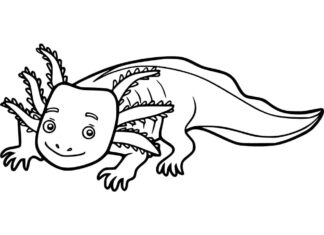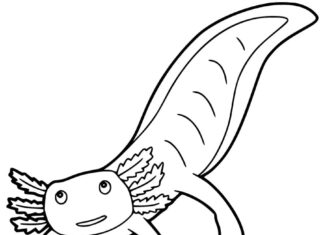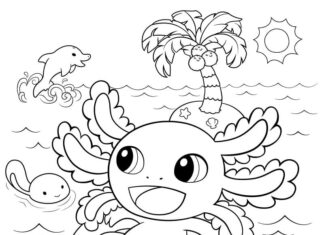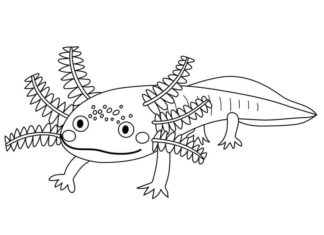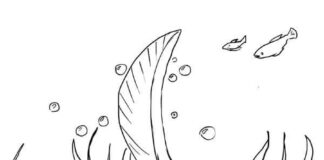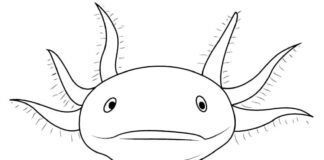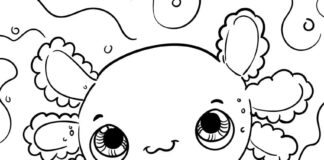Axolotl (Ambystoma mexicanum) is a unique species of amphibian in the moth family (Ambystomatidae) that is endemic to Mexico. The axolotl is known for its ability to retain its larval stage throughout its life, meaning that it reaches sexual maturity without going through the full process of metamorphosis.
Axolotl Coloring Pages
information
- Physical appearance: Axolotl is distinctive because of its long, rough skin and fin-like legs. It also has specific external gills that allow it to breathe underwater. Its coloration can range from brown to pink.
- No full metamorphosis: The axolotl retains its larval appearance and features throughout its life, which distinguishes it from most other amphibians that go through a process of metamorphosis as they grow up.
- Living environment: Axolotl naturally occurs in lakes and canals in Mexico, primarily in Lake Xochimilco and Lake Chalco in Mexico. Due to habitat loss and water pollution, the axolotl's population in the wild is threatened.
- Body regeneration: Axolotl is famous for its remarkable ability to regenerate tissues and organs. It can even reconstruct complex structures such as limbs, the heart and the brain. This makes it a target for scientific research in the field of tissue regeneration.
- Scientific applications: Due to its regenerative ability, axolotl is being intensively studied to understand the mechanisms of tissue regeneration. This could lead to important discoveries in regenerative medicine and gene therapy.
- Threats: Axolotl is endangered due to habitat loss, water pollution, introduction of predators, and trade as pets and laboratory animals.
- Domestic animals: Axolotl are also kept as pets in aquariums and terrariums. They are prized by animal lovers for their unusual appearance and behavior.
- Key symbolism: Axolotl has become a symbol of the ability to regenerate and rebirth in culture and literature. It is also an important element in Mexican mythology and local beliefs.
trivia
- Larval immortality: One of the most surprising features of the axolotl is its ability to retain its larval stage throughout its life. This means that it does not go through the full process of metamorphosis, which allows it to retain the characteristics of a young larva, such as external gills.
- The ability to regenerate: Axolotl is known for its remarkable regenerative ability. It can restore lost body parts such as limbs, heart, lungs and even parts of the brain. This makes it a subject of scientific research in the field of tissue regeneration.
- Mexican mythology: In Mexican culture, the axolotl is an important part of mythology and beliefs. In ancient Aztec cultures, it was considered a symbol of transformation and rebirth.
- Threats and extinction: The axolotl population in the wild is threatened due to habitat loss, water pollution and the introduction of prey species. In 2010, the International Union for Conservation of Nature (IUCN) classified the axolotl as a critically endangered species.
- Research: Because of its regenerative ability, axolotl is being studied intensively by scientists. Finding out how this process occurs in axolotl could have implications for regenerative medicine and gene therapy in humans.
- Popularity as a pet: Axolotl have become a popular choice as pets in aquariums and terrariums. They are prized by animal lovers for their unique appearance and behavior.
- Laboratory adaptations: Axolotl is sometimes used in laboratory research related to regeneration and genetics. Its ability to regenerate makes it an interesting model for studying biological processes.
- Mexico's aquatic ecosystems: Axolotl naturally occurs in lakes and canals in Mexico, primarily in Lake Xochimilco and Lake Chalco. These unique aquatic ecosystems are important for the conservation of this species.
- The impact of the environment on development: If the axolotl is subjected to stress or chemicals, it can undergo a process of metamorphosis and transform into a form resembling an adult salamander.
- Help with genetic testing: Axolotl has a large genome, making it an interesting subject for genetic research. Learning about its genome can help understand evolution and genetic differences between species.


